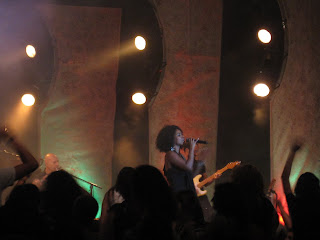One of the greatest parts of this opportunity to intern for the IAEJ has been getting to learn about Ethiopian Jewish culture through various first-hand experiences. Beyond the absorption centers, the politics, and the cultural obstacles which so many focus on in today's society, the Ethiopian community has also brought with it a tremendously rich heritage to Israel
For the first time in thirty years, instead of a one-day celebration, the Sig’d festivities began two weeks in advance with a well-attended celebration at the Beit Hanassi (President’s Residence) in Jerusalem, with several moving speeches, followed by a panel discussion led by President Shimon Peres himself. This was especially remarkable as it was the first year celebrating the holiday on such an official level, as it was only legislated a national holiday in the Knesset in 2008 (thanks to the lobbying efforts of the IAEJ). When Peres approached the dais, I expected a lengthy speech, but instead he briefly touched on the achievements of the Ethiopian community in Israel
The questions ranged from giving advice to Ethiopian-Israeli youth, to telling a story of the first time each of them was proud to be part of the Israeli community. The panelists spoke beautifully and at the same time candidly about their experiences, and advice was given to be optimistic about the future, but to never forget the past. The event concluded with Hatikva , Israel
Though I don't speak a word of Amharic, and the service was led by the Kessim almost entirely in the native Ethiopian language, the overall experience was immensely powerful. Not only was it powerful in the numbers of Ethiopian-Israelis who joined in celebration (an estimated 15,000 people) in this magnificent setting, but also in the intense religious fervor felt at the promenade that morning and the blending together of all generations of Ethiopian Jews.
While most of the young people seemed more excited to mingle with friends and relatives than participate in the religious ceremony, the community’s elders gathered close together, softly murmuring along with the Kessim on stage.
Although this religious ceremony was entirely foreign to me, I did have some connection to it, as I knew that even as much as I stood out from the crowd as a white American, we are all Jews. They say that when a Jew travels to a foreign land, he will always find comfort in the land’s synagogue, hearing the words of the Shema recited. Perhaps I didn’t hear the familiar Hebrew phrase at this particular religious service, but standing in the middle ofJerusalem
While most of the young people seemed more excited to mingle with friends and relatives than participate in the religious ceremony, the community’s elders gathered close together, softly murmuring along with the Kessim on stage.
Although this religious ceremony was entirely foreign to me, I did have some connection to it, as I knew that even as much as I stood out from the crowd as a white American, we are all Jews. They say that when a Jew travels to a foreign land, he will always find comfort in the land’s synagogue, hearing the words of the Shema recited. Perhaps I didn’t hear the familiar Hebrew phrase at this particular religious service, but standing in the middle of
That same night concluded the Sig’d holiday with a beautiful portrayal of Ethiopian-Israeli talent at a high-powered presentation at the Israel Convention Center
The last time I was at the Convention Center was for a concert of the Idan Raichel Project – a musical project that incorporates not only Ethiopian singers and musicians, but also many Amharic lyrics – and even then, I couldn't stop thinking about how great the presence of Ethiopian Jews is in Israeli society and Israeli history.
One of the members of the Idan Raichel Project, October 25
Three weeks later, to be in that same auditorium at final event in honor of the Sig’d, to see the impact of Ethiopian-Israelis in all spheres of Israeli society was another level of achievement. What I expected to be night in celebration of Ethiopian culture and heritage was actually a night in celebration of Israeli culture and heritage and the role of Ethiopian-Israelis within it, and it turns out that role is pretty impressive.
 Welcoming the newest Oleh from Ethiopia, who arrived just two days previous to the event, and presenting him with his Israeli citizenship
Welcoming the newest Oleh from Ethiopia, who arrived just two days previous to the event, and presenting him with his Israeli citizenship










Thanks for posting this. I traveled to Israel this past spring and had hoped to meet members of the Ethiopian-Israeli community. No such luck.
ReplyDelete